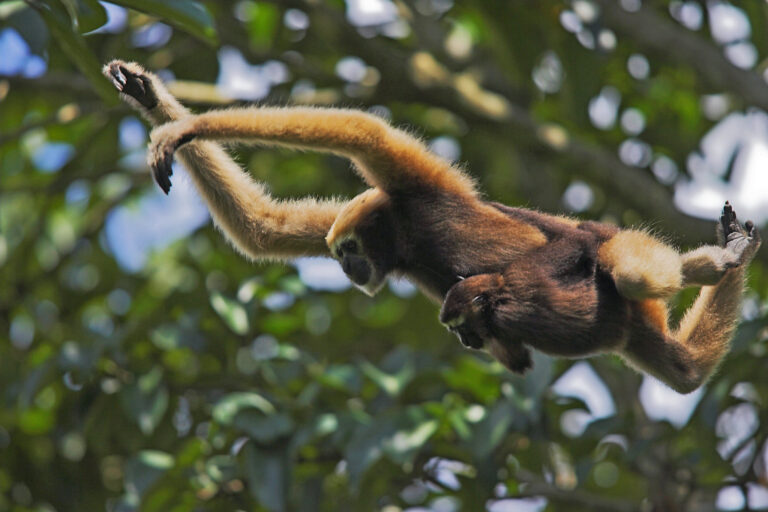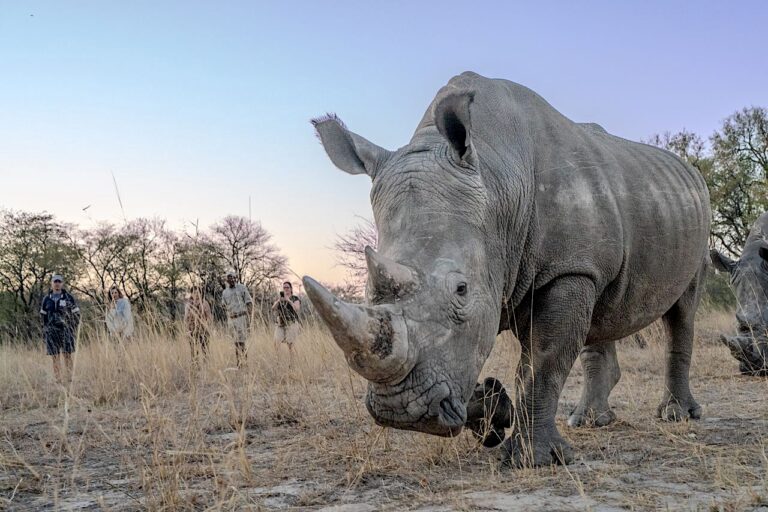- Nepal’s environment minister has suggested selling licenses to hunt tigers in the country as a means of both controlling the predator’s population and raising money for conservation.
- But conservationists, wildlife experts and local communities have denounced it as a “terrible idea,” saying it would endanger the tigers and their wider ecosystem, as well as violate Indigenous beliefs.
- Researchers warn hunting is ineffective and unnecessary as a means of reducing human-tiger conflict, and that the tiger population may have reached its natural limit in the country anyway.
KATHMANDU — Nepal’s environment minister has suggested allowing wealthy foreigners to kill tigers for “sport,” sparking outrage from wildlife experts, conservationists and local community representatives.
Birendra Mahato raised the issue in a recent podcast interview, where he said he’d received offers from U.S. and Japanese hunters who wanted to pay millions of dollars to kill a tiger in Nepal. The country represents a rare conservation success story for the big cat, Panthera tigris, whose population here has tripled over the past 12 years.
“They told me that we could go into global bidding, and allow the highest bidder to hunt tigers for a month every four to five years,” Mahato said.
He pointed out that Nepal would soon face the problem of having too many tigers for its limited space and resources, which could lead to increased conflicts with humans and lack of food for the animals. The money raised from selling hunting could be used for conservation work, he added.
“We could charge $25 million for every tiger killed,” he said. At that price, the cost of killing five tigers would easily cover the environment ministry’s total budget for the 2023/24 fiscal year.
But Mahato’s suggestion and justifications have come under scathing criticism from conservationists, experts and local communities. They say “sport hunting” would be a disastrous move that would jeopardize Nepal’s remarkable achievement in tiger conservation and pose serious ecological and cultural risks.
“Hunting just doesn’t work to reduce conflict,” Mark Elbroch, director of the puma program at global wildcat conservation NGO Panthera, told Mongabay.

Elbroch led a recently published study proposing five hypotheses for why killing carnivores such as tigers might not just fail to stop their predation of livestock, but could even exacerbate the problem.
The study suggests that killing tigers may have unintended consequences such as increasing local tiger density, attracting new or neighboring tigers who may be less wary about preying on livestock, disrupting the predator-prey balance, causing prey species to change their behavior and distribution, and creating a false sense of security among people.
“When hunters are given guns, and allowed to kill, they can kill any tiger in the habitat,” Elbroch said. “That tiger could have a specific role in the population and its death could have negative impacts on the entire population.”
There may be certain traits, such as skin color, size or even shape that the hunters might prefer, and it’s possible that if they only target such tigers, it could lead to a loss in these traits in the population, conservationists say.
Neil Carter, an associate professor of environment at the University of Michigan, who recently studied social networks among tigers in Nepal’s Chitwan National Park using long-term camera trap data, said tigers of different sexes and ages have important roles to play in the social network. That means the loss of individuals central to the network could create disproportionate disruptions to the population.
For example, resident adult male tigers play an important role in maintaining the network. They connect different clusters of tigers together as they travel long distances to mate with multiple females. They also protect their territory from other males who might try to mate with their females or kill their cubs. Adult female tigers also have an important role in the network. If they live in a certain area for a long time, they’re more likely to connect to the wider network. They can also pass on their territory to their offspring, which is an advantage for their survival.
Another study shows that even the death of one or two tigers, especially females, could trigger a massive decline in the overall population. Female tigers not only give birth to young ones, but also nurture and protect them until they’re capable of living on their own.
In the case of cubs, only around 50% survive to the age of dispersal, said Bhim Gurung, a co-author of the study on social networks among tigers.
“If the main male tiger dies, the survival rate goes down further as the new male tries to kill all cubs born from the previous male,” Gurung, from the Nepal Tiger Trust, told Mongabay. The survivability of the cubs has important, long-term implications for the viability of the tiger population, Gurung added.

In addition to these potential ecological repercussions, hunting of tigers raises important cultural issues for members of local Indigenous communities, especially the Tharu people living around Chitwan.
“The indigenous communities living in areas that now fall under the national park were displaced so that the tigers could be saved,” said Birendra Mahato (not related to the environment minister), president of the Tharu Cultural Museum in Chitwan. “The communities have made a lot of sacrifices for Nepal to achieve the goal of doubling its tiger population.”
He added that tigers are part of their religious lives and they worship them: “It’s beyond imagination that they would allow anyone to come in with a gun and kill them regardless of the money they offer.”
Nepal faces a dilemma of coexisting with tigers, as the big cats’ population has grown from 121 in 2010 to 355 in 2023, thanks to intensive conservation efforts. At the same time, the country’s human population has also expanded in the southern plains, where most tigers live, thanks to a successful malaria eradication program in the 20th century. This has led to more cases of human-tiger conflict, as tigers and humans compete for the same space and resources.
Elbroch said he believes that “problem” tigers that attack and kill people should be removed, but only after confirming their identity through genetic tests.
Short of such definitive tests, “we need to rely on visible traits, and sometimes we even catch the wrong tiger,” a former veterinary technician, who asked not to be named, told Mongabay. “If we allow hunters to kill the problem tigers, they would be the last people to be able to identify them.”
Carter said “problem” tigers are unlikely to be part of the social network, and may have come into conflict with humans because of this. But he also said some of these tigers may play central roles in the network and their removal could have disproportionate impacts on the population structure.
Then there’s a question of securing enough food and habitat for the growing population of tigers. However, researchers say there’s a limit to the population growth, and it may have already been reached in Chitwan. A recent study suggests that the ecological carrying capacity for tigers may have essentially been reached in Chitwan due to the limited availability of prey populations in the area.
The authors note that prey densities estimated across the plains and hills of the Chitwan-Parsa site can support 177 adult tigers. The 2022 census indicates that the population there has already reached 155. The authors note that given the numbers, only small gains in population may be achieved in the future.
“The population will not continue increasing forever,” Elbroch said. “Limiting factors such as availability of prey and various climatic factors will come into play.
“But hunting is a terrible idea,” he added. “It’s a fly in the face of the collaborative efforts to save these wonderful animals.”
Banner image: Three Bengal tigers in India. Image by Brian Gratwicke via Wikimedia Commons (CC BY 2.0).
Abhaya Raj Joshi is a staff writer for Nepal at Mongabay. Find him on Twitter @arj272.
Nepal was supposed to double its tiger population since 2010. It tripled it
Citations:
Elbroch, L. M., & Treves, A. (2023). Perspective: Why might removing carnivores maintain or increase risks for domestic animals? Biological Conservation, 283, 110106. doi:10.1016/j.biocon.2023.110106
Carter, N. H., Wilson, E. C., & Gurung, B. (2023). Social networks of solitary carnivores: The case of endangered tigers and insights on their conservation. Conservation Science and Practice. doi:10.1111/csp2.12976
Carter, N. H., Pradhan, N., Hengaju, K., Sonawane, C., Sage, A. H., & Grimm, V. (2022). Forecasting effects of Transport Infrastructure on Endangered Tigers: A tool for conservation planning. PeerJ, 10. doi:10.7717/peerj.13472
Dahal, B. R., Amin, R., Lamichhane, B. R., Giri, S. R., Acharya, H., Acharya, H. R., & Harihar, A. (2023). Setting recovery targets for a charismatic species in an iconic protected area complex: The case of tigers (Panthera tigris) in Chitwan–Parsa National Parks, Nepal. Conservation Science and Practice, 5(6). doi:10.1111/csp2.12930
Feedback: Use this form to send a message to the author of this post. If you want to post a public comment, you can do that at the bottom of the page.














